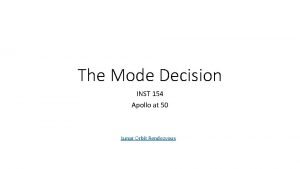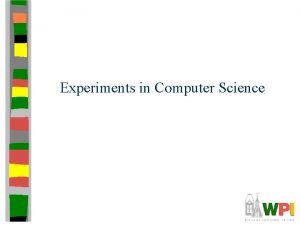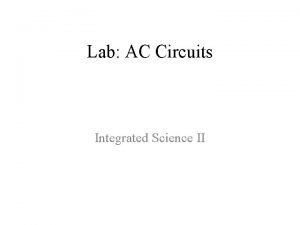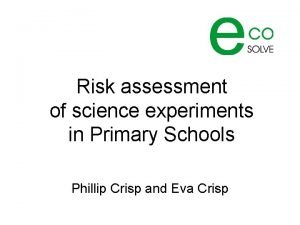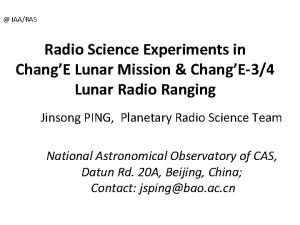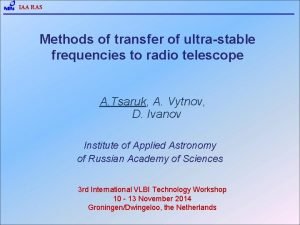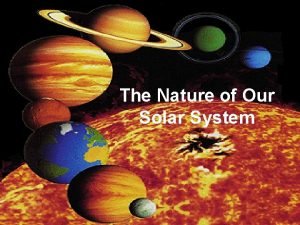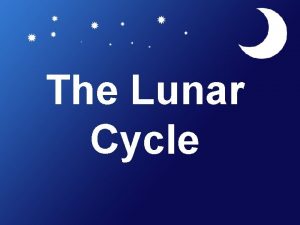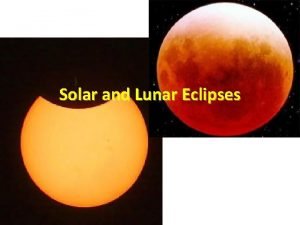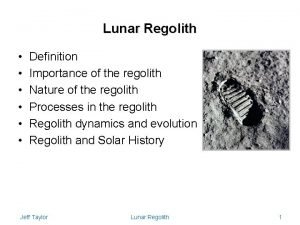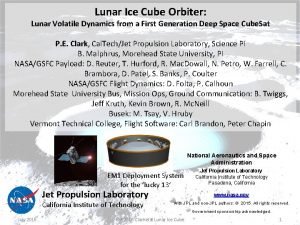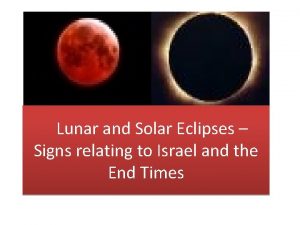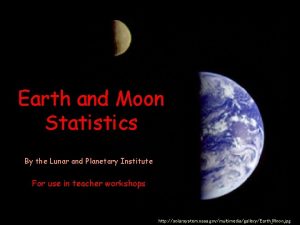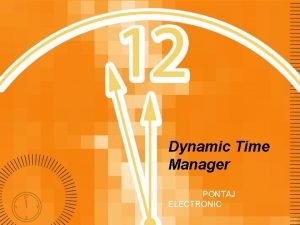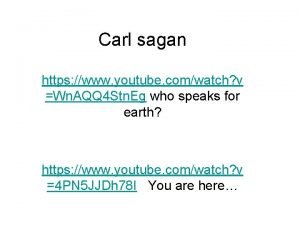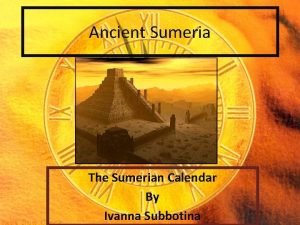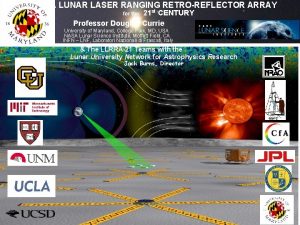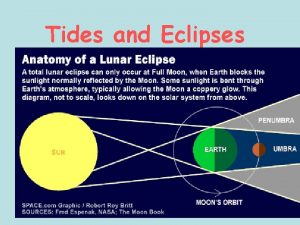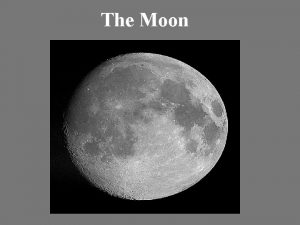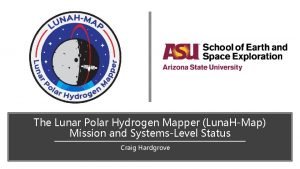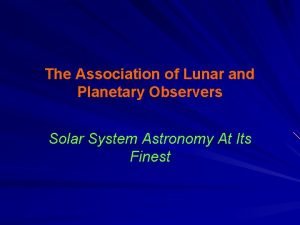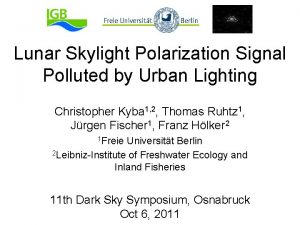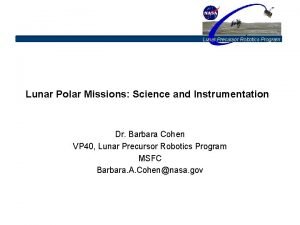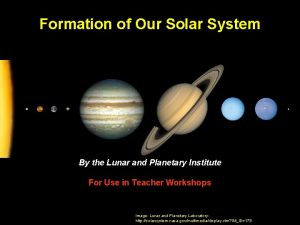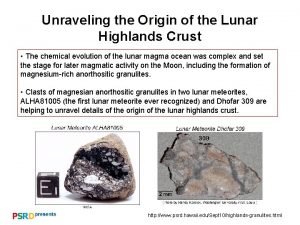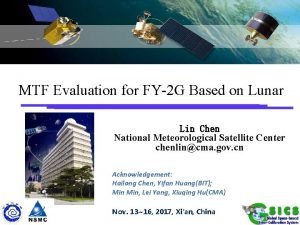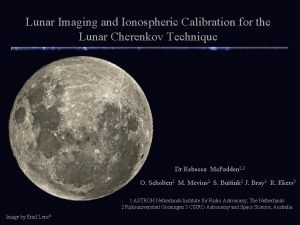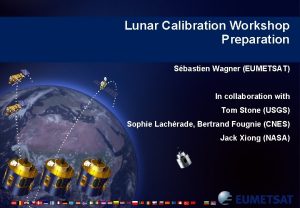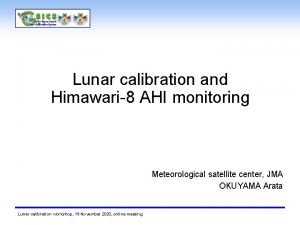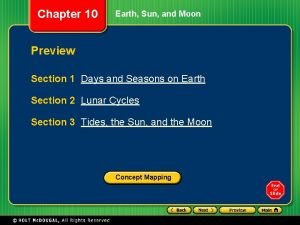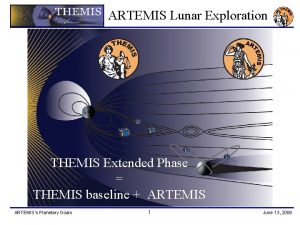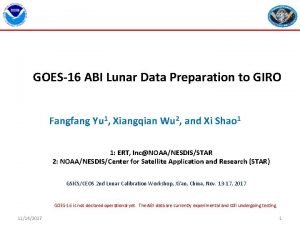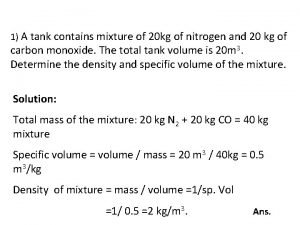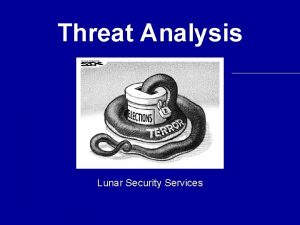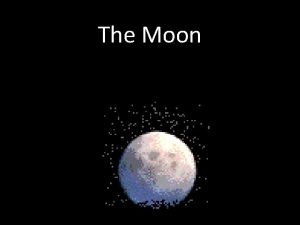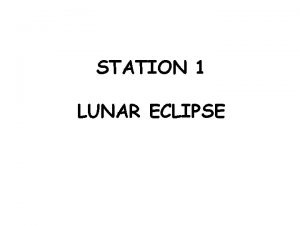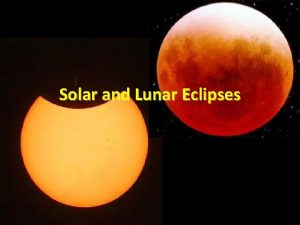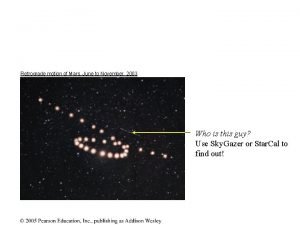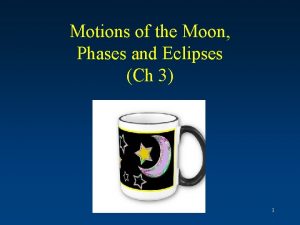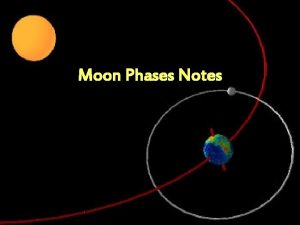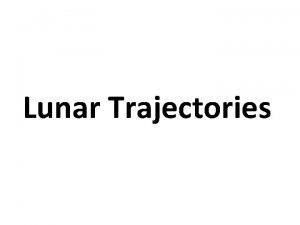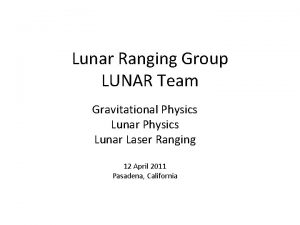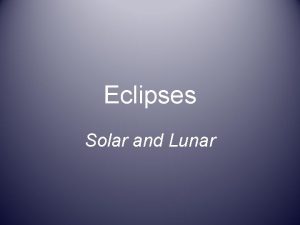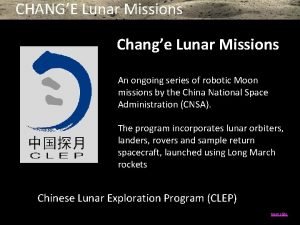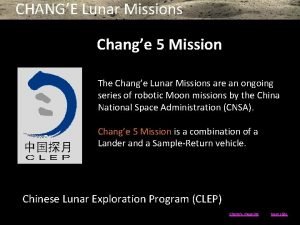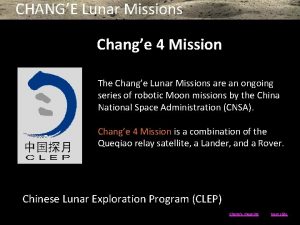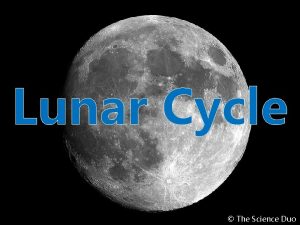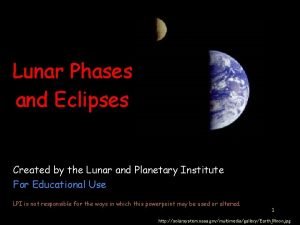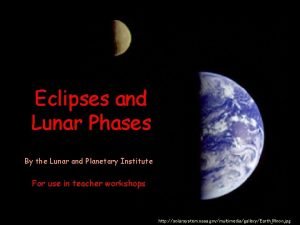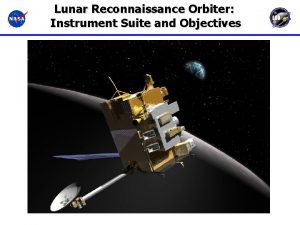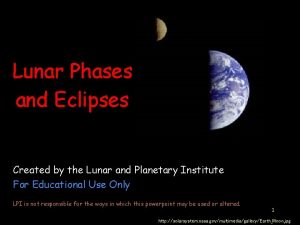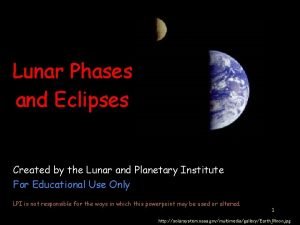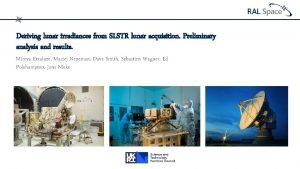IAARAS Radio Science Experiments in ChangE Lunar Mission



















































- Slides: 51

@ IAA/RAS Radio Science Experiments in Chang’E Lunar Mission & Chang’E-3/4 Lunar Radio Ranging Jinsong PING, Planetary Radio Science Team National Astronomical Observatory of CAS, Datun Rd. 20 A, Beijing, China; Contact: jsping@bao. ac. cn

Content Outline Radio science experiments have been involved in all of the CE-n lunar missions. Where in Chang’E-3 landing mission, 2 & 3 -way lunar radio-phase ranging (LRR) was developed and tested at X-band of 8470 MHz by radio science. This LRR method can become a new space geodetic technique to study the geodynamics, lunar dynamics, and to test theory of relativity, as LLR did. We successfully realized this new kind of space technique, in CE-3 mission and the preliminary result is presented here.

Three Phase of Chinese Lunar Exploration 1. 概况 Orbiting CE-1/2 2004 -2011 Landing CE-2/3/4 2010 -2018 Sampling Return CE-4/5 2017 -2020

Radio Science in Lunar & Deep Space Mission May Affect Navigation (Basic Works) • lunar/planetary gravity, topography • Lunar/Planets rotation and nutation • Celestial reference frame (tie ? ) • Planetary atmosphere, Ring… • Solar winds • Test experiments of relativity: Cassini Huygens Advantages: share TT&C system, without new payload Disadvantages: need state-of-art time-frequency techniques Joint the Explorations of Planetary Radio Sciences with Planetary Geodesy/Geophysics/Geodynamics Explorations

Mercury Large liquid core, global contraction Topography, gravity field, the Ph. L Venus Gravity field rotation changes, atm. ultra-fast rotating Mars Whether the plate is divided? Topographic dichotomy, tides Polar cap(shape & gravity change) gravity field, polar motion, nutation Mars shock? Reveal the planetary origin & evolution, Topography, gravity field & change, Rotation changes, direct detection of quake Follow RISE/SELENE team, 2001 Earth Home of Geodesy Chandler Wobble, earth liquid, forced nutation, free-core nutation, plateform, crustal variation, Earthquake Moon Metal core, LPh. L, dichotomy, origin, mascon, tide, gravity & topography, Moonquakes Asteroid Shape, gravity, rotation characteristics Galileo Satellite Moment of inertia and differentiation, tidal dissipation, liquid water Lunar/Planetary Geodesy/Geophysics/ Geodynamics Scenario

� 行器 双程上行� 路 � 送和双程接收站 双程下行� 路 地球 � /三程下行� 路 � /三程接收站 Open loop Doppler and range tracking with: (1) H-Clock at each ground station, table and precise; (2) X-band PLL transponder & transmitter on board; (3) Many antennas, VLBI & DSN of China TT&C (4) Open loop multi channel RSR with frequency resolution of 10^-16 Left: Radio Science Receiver for VLBI, R&RR, Pulsar observation

Radio Science Experiments in Lunar/Planetary Missions USO VLBI @ CAS

Radio Science: The 4 radio telescopes in China to serve CE missions, for VLBI and open loop Doppler and Ranging Coverage: EW 34° SN 18° Baseline length: 1115 km to 3249 km

Nanshan 25 m, Xinjiang, Updated this summer Work at UHF/L/S/C/X/K(22 GHz) With Very Long Baseline Interferometry Mode, Spectra analyzing (Line) Mode, Pulsar Mode, Dual Polarization Radio Science Receiver system & Backend VLBI recording system MK 5

Pulsar Timing System at Nanshan 25 m

Steerable 110 -meter Aperture Radio Telescope,Sm. ART Or: Qi. Tai Radio Telescope(QTT) Main focus: 100 cm, 30 cm, 15 cm Sub-focus: 3 mm, 6 mm, 10 mm 5 cm, 13. 6/3. 6 cm

Miyun 50 m at Beijing , NAOC/CAS Kunming 40 m at Kunming/Yunnan , YNAO/CAS S/X bands, Dual polarizations VLBI Mode, Pulsar observation, Ground segments for Lunar &

Sheshan 25 m @ SHANGHAI L/S/C/X/Q bands VLBI, Pulsar, Spectra line… Tianma 65 m @ SHANGHAI L/S/C/X/Ku/K/Ka/Q bands VLBI, Pulsar, Spectra line…

China VLBI Network: Applications in Chang’E -1/2 Missions u. CE-1/2 TT&C system consists of: 1. The traditional Unified S-Band command subsystem for range & Doppler; 2. Chinese VLBI Network (CVN) for delay & rate and angular position. u. VLBI plays role in: 1. 2. 3. 4. Earth-Moon transferring; Lunar orbiting; C 1 Positioning the Lunar surface impact C 2 Moon-Halo orbit transferring. u. VLBI Obs. Modes: 1. E-VLBI & normal VLBI 2. Narrow & Wide Band 3. Astronomical & DOR/DOD

Real-time monitoring CE-1/2 Lunar Orbit Insertion CE-1: Ping J. et al. , 2007, Wang M. et al. , 2012 CE-2: Ping J. , Li J. , Han T. , Wang M. , 2010 Begin of Maneuver Doppler / m/s End of Maneuver ____ : different maneuvers ____ : best predicted maneuver ____ : observed data Time / sec

CVN has contributed to the orbit monitoring of the CE-1 satellite for all the stages including phases of transfer, capture, mission and landing. South latitude/deg East longitude/deg Hight/m 52. 255 -1. 657 -2562

Improving Lunar Gravity and Topography by CE Missions CE-1 Tracking Data Coverage On CLTM-s 01 topography model Lunar DEM is improved by ~20 meter with VLBI + RR&R POD data Lunar mean moment of inertia 0. 393466± 0. 000065 Love number k 2 0. 0242± 0. 0004 LP 100 k SGM 100 h Gravity Error Spectral CEGM is 2 times better at low orders/degrees CEGM 50 c

Nature Geoscience, Harada, Matsumoto, Sander, Yan, Ping … 2014 Lunar Deep Interior Structure by CE-1: Moon is still active

Lunar topography and gravity before and after CE-1 and SELENE missions Topography: NLT 180 A (Ping et al, 2002) Gravity: LP 165 p

Shield Volcanoes in Oceanus Procellarum CLTM-s 01 ULCN 2005 Aristarchus 25. 4 N, 50 W, 2. 0 km ~3. 8 GA Marius Hills/ YUTU 14 N, 52 W, 2. 1 km 1. 1~3. 5 GA Ping et al. , 2009 Spudis et al. , 2013 Kiefer 2013 Gravity

Marius Hills and Yutu Shield Volcano CE-1 DEM Ref. HUANG Q. this meeting Marius: intense volcanic activity, over 300 cones and domes, numerous sinuous rills, collapse pits

Fitzgerald-Jackson basin is a mascon basin 25 o. N 191 o. E 470 Left/up: Image Left/low&Right/up: LAM Topography Right/low: Gravity Impact crater

Near Side Mascons (Black Circles-New discovered) Global Crust Thickness Thinnest middle scale crust basins area are identical with BGA area. Far Side Mascons (Black and White Circles-New discovered)

Some newly identified Farside and Limb Hidden Mascon Basins Basin Name or Suggested Code Szilard Location Diameter Height(KM) RIM Bottom (Eo, No) (KM) 105. 7, 122 -1. 1 -4. 1 34. 0 Fitzgerald -Jackson 191, 25 470 3. 2 -0. 6 CEFC 01(unnamed) 178, 50 230 2. 2, 0. 4 -0. 3 CEFC 02(unnamed) 269, 26 310 -0. 5 -1. 5 CEFC 03(unnamed) 105, 61 290 -3. 0 -4. 4 CEFC 04(unnamed) 176, -44. 190 -4. 5 -7 8 Amundsen 130, -81 348 -1. 0 -3. 0 Ganswindt Cruger-Sirsalis 293, -15. 5 310 0. 3 -2. 5 BGA(m. Gal) RIM Bottom 50 256 Type II -226 -130 24 140 560 84 220 266 291 722 III III III 110 370 II -90 260 II Mascon types were defined by Namiki et al. , 2009 Bouguer gravity can also give clear clue for hidden mascons:

Chang’E 3—Lander in-situ exploration and rover exploration Launch: early Dec. 2013, life time >12 months, Rover track: >10 km Chang’E 4 will be a backup landing mission (2018~2019) Lander Rover

Scientific Instruments on CE-3/4 Lunar Lander TT&C Panoramic antenna Mast camera Liberating mechanism for lunar rover X-band Medium gain antenna HGA for data transmission Moon-based optical astronomical telescope E-UV telescope Solar array cushioning mechanism for landing Attitude control engine TT&C antenna Main thruster

Rover and its main payloads X ray spectrometer, Infrared spectrometer panoramic camera Fixed-direction data transmission Antenna Solar battery matrix Mast Navigation camera Wheel Mechanical arm Rotating arm Ground penetrating radar system 28

Antenna for 2 -way tracking @ Jiamusi, northeast China S/X bands 66 m in diameter TT&C antenna With 2 H-clocks VLBI available Pulsar obs. available Antennas for 2 -way tracking @ Kashi & in Agentina, 35 m in diameter, S/X/Ka bands, same options as 66 m.

MEX OD ability tested by new developed Radio Science Receiver RSR: 4 ch, VLBI recording, RS, Doppler, Phase retrieving Ø In CE-1/2, MEX & VLBI experiments, we obtained open-loop Doppler data and Ø Ø carried out POD; MEX 3 -way Doppler: <0. 2 mm/s of 1 points per second; VEX RS-RO experiments were carried our with ESA VEX RS team; Now, H-Clocks (10^-14 ~ 10^-15) used in all stations. Comparing with LLR, ionospheric effects at up/down link station is extra error sources, can be removed by GNSS-TEC or dual frequency obs.

Why LRR with LLR there ? Scientific objectives: 1. To realize radio ranging (<0. 5 mm resolution, 2~3 mm error; where 2~3 cm ranging error in LLR) 2. To monitor lunar orbit and rotation 3. To measure the LPh. L 4. To prepare for Mars ranging 5. To study the general relativity

Disadvantages for LLR: weather effect, and strict pointing limitation, a few telescope can do (geometric limitation) Moon Full Moon New Moon Sun No data Earth - large data gaps near Full and New Moon Radio Phase Ranging can fill the gap of Full Moon; may also fill the gap of New Moon with enough power onboard lander.

Advantages at Radio Band • weather free • less pointing limitation • Track many landers at same time for small antenna, with large beam size • Easy assembling with state-of-art software radio technique, time&frequency technique

Photo: Z. Wang, J. Ping, A. Gusev, W. Li Chang’E-3 3 Way Ranging/Doppler Tracking 1 st Miyun/Beijing Observation

3 -way Doppler and Phase Ranging of CE-3 lander: Recent result: rms 1 sigma< 10 m. Hz @ X band 1 pps. It is good enough for combining with LLR Integration 1 s • Real Time Close Loop 0. 12 Open Loop 0. 24 • Post Close Loop 0. 06 Open Loop 0. 12 Unit 10 s RMS 0. 04 0. 07 0. 02 0. 04 mm/s A new kind of space geodetic method/technique is born/started.

Data Processing for LRR • Followed the idea of LLR technique • Rejecting the low elevation angle (<20°) measurement, • Calculating and removing the atmospheric delay series by using a Saastamoinen-NMF model based on the metereological data. • An IONEX GIM global ionospheric TEC product released by IGS-GNSS of IERS was used to calculated the ionospheric delay between the ground station and lander. • The position of lander was estimated with some fixed parameters, EOP from IERS products, lunar liberation from LE 430/DE 430, solid earth tide model of the ground station from IERS standard. • The estimated coordinates for lander position are read as 19. 50456°W and 44. 1210°N with a fixed radii of 1734. 7680 km at landing area. • The radii value was calculated from LOLA/LRO DEM model.

2 -way LRR result L_up: 1 sps CE-3 LRR in one pass R_up: O-C range and elevation angle R_low: 1 sps range residual -9 mm~27 mm atmospheric disturbulance can be reduced by using micro-wave radiometer or by filting the high frequency signal out

Future works 1: CE-3 lander LRR observations to improve data analysis for (1) EOP, LPh. L, ground site position; (2) combining 2 - & 3 - way data; (3) combining LRR and LLR data

Future works: 2 Frequency remote transfer between Earth and Moon, or between to geo-sites of hundreds and/or thousands KM. 3 Radio Navigation in Earth-Moon or Lunar space

L 2平动点中继卫星 嫦娥-4探测任务测控 月球及月背面着陆器 Chang’E-4 Lunar Farside Lander with a Relay Satellite at L 2 point of Halo Robit ~50 um R&RR量 2程 + 4程 测量 2 -way LRR + 4 -way LRR Atm/Iono E 1 Site 1 up 2 down links E 2 Site 2 downlinks

Future work 4 : 4 -way ranging in CE-4 mission with relay S/C and a farside lander Beyond the lunar and geo dynamic studies, it can be used as pathfinder mission for the techniques in future space gravitational wave exploration. With sensitivity about 1 order better than in CASSINI mission, due to a method of atmospheric disturbulance free method by combining a 2 -way LRR with a 4 -way LRR at same time.

CE-4 lunar Far-side Radio Astronomy: 100 KHz~40 MHz low frequency • • Solar Radio Burst type: II, III Low frequency radio emission from our galaxy Planetary radio burst: Jupiter & … Lunar ionosphere Relay S/C Lander

CE-4 lunar Far-side Radio Astronomy: 100 KHz~40 MHz low frequency Nature Radio@ 1 AU & Moon

RAE-2 occultation of Earth 44

diffractive screening. Radio propagation around the Moon, with subsurface penetration and a lunar density model Takahashi and Woan 45


lunar exosphere • Dual-frequency Luna spacecraft measurements give reasonably good evidence that an ionised layer, several kilometres thick, builds up on the illuminated side of the Moon (Vyshlov 1976) • Max illuminated plasma frequency of ~0. 5 MHz • No layer seen during the lunar night RS-RO for Lunar Ionosphere Luna 22

Solar Burst

Jupiter Radio Emission


Future work (3): Martian Radio Ranging, scince 2016 with INSIGHT mission of NASA ~2 cm ranging accuracy or better

Thank You For Attentions !
 Lunar landing mission
Lunar landing mission Science experiments for highschool
Science experiments for highschool Computer science experiments
Computer science experiments Investigating conductors lab report
Investigating conductors lab report Science risk assessment primary school
Science risk assessment primary school What is a profession
What is a profession Iaaras 52
Iaaras 52 Iaaras profession
Iaaras profession Trunked radio vs conventional radio
Trunked radio vs conventional radio Favorite subject is science
Favorite subject is science Uranus belt
Uranus belt Waxing crescent moon tattoo
Waxing crescent moon tattoo Differentiate between lunar eclipse and solar eclipse
Differentiate between lunar eclipse and solar eclipse Regoloth
Regoloth Lunar ice cube
Lunar ice cube Lunar eclipse israel
Lunar eclipse israel Moon stats
Moon stats Pontaj electronic
Pontaj electronic Carl sagan lunar eclipse
Carl sagan lunar eclipse Summerian calendar
Summerian calendar Lunar laser ranging retroreflector array
Lunar laser ranging retroreflector array What type of tide occurs at a lunar and solar eclipse?
What type of tide occurs at a lunar and solar eclipse? What is the phase of the moon during a lunar eclipse
What is the phase of the moon during a lunar eclipse Lunar polar hydrogen mapper
Lunar polar hydrogen mapper Association of lunar and planetary observers
Association of lunar and planetary observers 300 solar years to lunar years
300 solar years to lunar years Heart
Heart Lunar skylight
Lunar skylight Lunar precursor robotic program
Lunar precursor robotic program Lunar 1996
Lunar 1996 Chinese new year jeopardy
Chinese new year jeopardy Lunar legend festival riddles
Lunar legend festival riddles Lunar
Lunar Telluric
Telluric Lunar survival activity
Lunar survival activity Lunar
Lunar Lunar
Lunar Lunar
Lunar Solar eclipse chapter 10
Solar eclipse chapter 10 Lunar
Lunar Posterior lunar hymen
Posterior lunar hymen Lunar
Lunar A lunar excursion module weighs 1500 kg
A lunar excursion module weighs 1500 kg Lunar security
Lunar security What is the moon made of
What is the moon made of Lunar
Lunar What is an eclipse
What is an eclipse Diferença entre eclipse lunar e solar
Diferença entre eclipse lunar e solar Partial lunar eclipse
Partial lunar eclipse Moon phases and eclipses
Moon phases and eclipses Phases of the moon notes
Phases of the moon notes Lunar
Lunar
